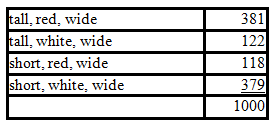If tall (D) is dominant to dwarf (d), and two homozygous varieties DD and dd are crossed, then what
kind of offspring will be produced?
a. all intermediate forms
b. all tall
c. all dwarf
d. 1/2 tall, 1/2 dwarf
e. 3/4 tall, 1/4 dwarf
B
You might also like to view...
Similar gill pouches in embryos of a chick, human, and cat are an example of _____
A) structural homology B) developmental homology C) genetic homology D) the inheritance of acquired characters
How does recombination frequency relate to activities in the cell?
a. Recombination frequency relates to activities in the cell by the frequency at which mutation disrupt the proper functioning of a gene. b. Recombination frequency relates to activities in the cell by the frequency at which post-transcriptional editing results in new functions for the product of a gene. c. Recombination frequency relates to activities in the cell by the frequency at which crossing over in meiosis separate two genes that were located on the same chromosome. d. Recombination frequency relates to activities in the cell by the frequency at which non-disjunction errors are generated by chromosomes refusing to separate during anaphase I.
If two or more of the genes are linked, what map distance separates them?
In peas, tall (T) is dominant to short (t), red flowers (R) is dominant to white flowers (r), and wide leaves (W) is dominant to narrow leaves (w). A tall plant that has red flowers and wide leaves is crossed to a short plant that has white flowers and narrow leaves. The resulting progeny are shown in the table.

A) 4 m.u.
B) 12 m.u.
C) 24 m.u.
D) 50 m.u.
E) None of the genes are linked to each other.
A mutation that occurs naturally, without exposure to a known mutagen, is called a(n) ________
Fill in the blank(s) with correct word